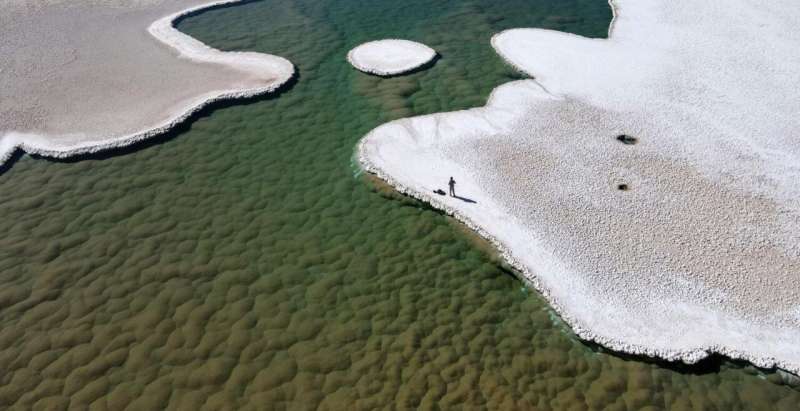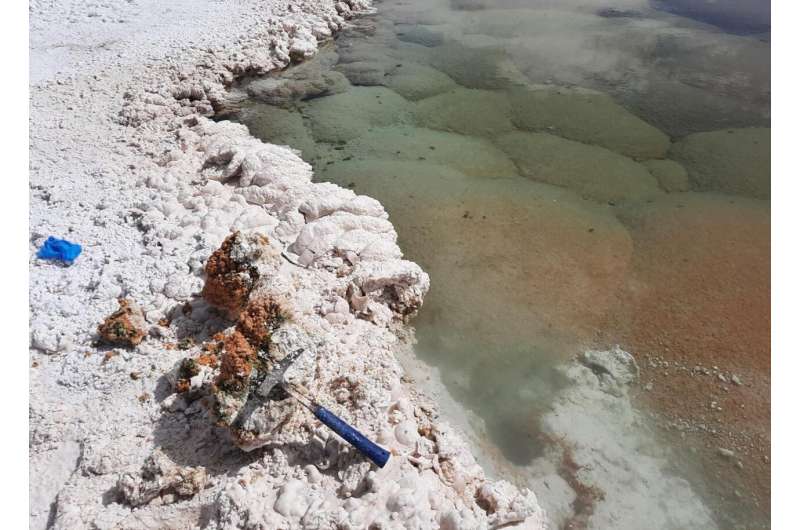This article has been reviewed according to Science X's editorial process and policies. Editors have highlighted the following attributes while ensuring the content's credibility:
fact-checked
trusted source
proofread
Deep within an inhospitable desert, a window to first life on Earth

CU Boulder geologist Brian Hynek has helped to document what may be a unique kind of ecosystem on Earth—and a possible window into the earliest stages of life on this planet 3.5 billion years ago, and even life on ancient Mars.
This alien environment, which was previously unknown to science, is made up of a system of lagoons surrounded by vast salt plains. They sit in Argentina's Puna de Atacama, a high plateau desert more than 12,000 feet above sea level. It's among the driest environments on Earth. Here, rain rarely, if ever, falls, and sunlight beats down unforgivingly, creating an environment few plants or animals can survive.
But, according to new research, the lagoons are home to something else: Vibrant displays of stromatolites, or complex microbial communities that form giant mounds of rock as they grow, a bit like corals building a reef millimeter by millimeter.
Hynek's preliminary observations suggest that these communities may resemble stromatolites that existed during a period in Earth's history called the early Archaean, when oxygen was almost nonexistent in the atmosphere.
"This lagoon could be one of the best modern examples of the earliest signs of life on Earth," said Hynek, professor in the Laboratory for Atmospheric and Space Physics (LASP). "It's unlike anything I've ever seen or, really, like anything any scientist has ever seen."
Hynek and Maria Farías, a microbiologist and co-founder of PUNABIO SA Environmental Consulting, will present their findings Dec. 11 at the 2023 meeting of the American Geophysical Union in San Francisco.
The researchers hope to return to the lagoon soon to confirm their initial results. Hynek called finding this alien environment "the biggest eureka moment I've ever had in my life."
"It's just amazing that you can still find undocumented things like that on our planet," he said.
Eureka moment
Getting to the lagoon was an adventure in and of itself.
Through his career, Hynek has traveled to some of the most extreme environments on Earth to understand how life might thrive on alien planets and moons. He's climbed to the top of the world's tallest active volcano, Ojos del Salado on the border between Argentina and Chile, and has traveled to Antarctica to search for fallen meteorites.
In April 2022, Farías brought him to one of her study sites in northwest Argentina. To get there, the scientists drove roughly nine hours down a dirt road. They stayed in a village of about 35 people who rely on a single spring for water. On his last night in the village, Hynek was perusing satellite images of the surrounding desert and saw something strange: what looked like a network of lagoons tens of miles away.
Intrigued, he and Farías drove as far as they could, then hiked several miles in the blazing sun.
"In some places, we were sinking up to our knees in salt slush," he said.
When they arrived at the lagoon, however, Hynek immediate knew that they had found something special.
The network of 12 lagoons stretched over roughly 25 acres and was ringed by barren mountains in the distance. Beneath its crystal clear waters, Hynek could see giant mounds of green growth, some 15 feet wide and several feet high. They were stromatolites, but unlike any he had ever seen.

Running out of time
Stromatolites, in general, refer to a range of microbial communities that are associated with layers of rock. They exist on Earth today, including off the coast of the Bahamas, but modern stromatolites tend to be relatively small. They also grow passively by trapping grains of sand and other detritus floating in the ocean.
Ancient stromatolites, in contrast, could stretch to 20 feet tall. They actively pulled in calcium and carbon dioxide from the surrounding water, causing minerals to precipitate around them.
The mounds in the Atacama lagoons looked a lot more like some of those Archaean communities than anything alive on Earth today.
Their rocky layers were constructed mostly from gypsum, a common mineral in many stromatolite fossils but absent in almost all modern examples of stromatolites. Biologically, they were made up of an outer layer of photosynthetic microbes called cyanobacteria and a pinkish core rich in archaea—single-celled organisms often found in extreme environments on Earth.
"We think these mounds are actually growing from the microbes, which is what was happening in the oldest ones," Hynek said.
Why they formed at this one, harsh location isn't clear. The lagoon environment could resemble the conditions on ancient Earth, Hynek said—the waters are salty and acidic and, because of the high elevation, are exposed to severe levels of solar radiation.
The communities could also provide scientists with an unprecedented look at how life may have arisen on Mars, which resembled Earth billions of years ago.
"If life ever evolved on Mars to the level of fossils, it would have been like this," Hynek said. "Understanding these modern communities on Earth could inform us about what we should look for as we search for similar features in the Martian rocks."
Hynek and Farías are hoping to conduct further experiments to confirm that these new stromatolites are, indeed, actively building their rocky formations—and explore how the microbes manage to survive the harsh conditions.
The scientists, however, may be running out of time. A company from outside Argentina has already leased the area to mine for lithium. Once drilling begins, the Atacama lagoons could be irreversibly transformed.
"This entire, unique ecosystem could be gone in a matter of years," Hynek said. "We're hoping that we can protect some of these sites, or at least detail what's there before it's gone or disturbed forever."
More information: Conference abstract: agu.confex.com/agu/fm23/meetin … pp.cgi/Paper/1447452
Provided by University of Colorado at Boulder



















